10 Cool Line Drawings Famous Examples
The greatest drawer in the world could have been a female apprentice to another artist in rococo France, or a Renaissance draftsman rendered invisible by the glare of an acknowledged master from a more than powerful nearby city-state, or a self-effacing art teacher currently working in Minnesota. Choosing the top 10 drawers of all time is a parlor game of dubious value. Instead, we decided to tally the number of times historical figures were referenced or reproduced in the first 10 issues of Drawing magazine and showcase them with illuminating comments from a thoughtful working artist and a representative from one of the near respected art institutions in the state. Each of the 10 artists featured here offers drawings of exquisite beauty; just, more important to our purposes, each one offers insights and lessons whatever draftsman tin can use. We explore why the piece of work of these individuals is so inspiring.
Leonardo da Vinci
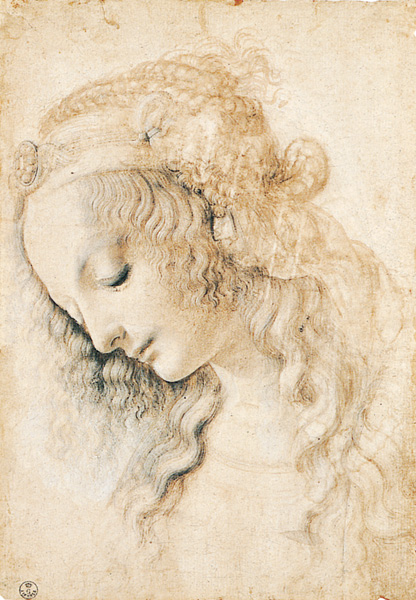
Leonardo da Vinci (1452–1519) was art'southward first undeniable superstar, and his genius is indisputable. But Ephraim Rubenstein, an artist who teaches at the Art Students League of New York, in Manhattan, mixes his admiration for Leonardo with the point that even this Renaissance bully did non sally from a vacuum. "Leonardo got so much from Andrea del Verrocchio, who was a tremendous teacher," says Rubenstein. "Everyone comes out of a tradition; nobody comes from nowhere. Leonardo learned the ancestry of sfumato from [his teacher], amongst many other things." Born the illegitimate son of a lawyer in the Tuscan town of Vinci, Italy, Leonardo was a scientist, an inventor, a pioneer in the written report of anatomy and the painter of the masterpieces The Concluding Supper and Mona Lisa—the prototypical Renaissance man. Rubenstein refers to his lines equally "mellifluous, fragile and graceful. He doesn't do anything that doesn't accept the most beautiful curves." But his sketchbooks are what brand Leonardo an innovator. "He was one of the commencement guys who talked about taking a notebook out into the streets," explains Rubenstein. "Leonardo said you must have direct contact with life and notice men'southward deportment."
Resources:
- Leonardo da Vinci Main Draftsman, past Carmen C. Bambach (Metropolitan Museum of Art, New York, New York)
- Leonardo da Vinci: The Complete Paintings and Drawings, by Frank Zollner and Johannes Nathan (Taschen, Cologne, Federal republic of germany)
Michelangelo Buonarotti
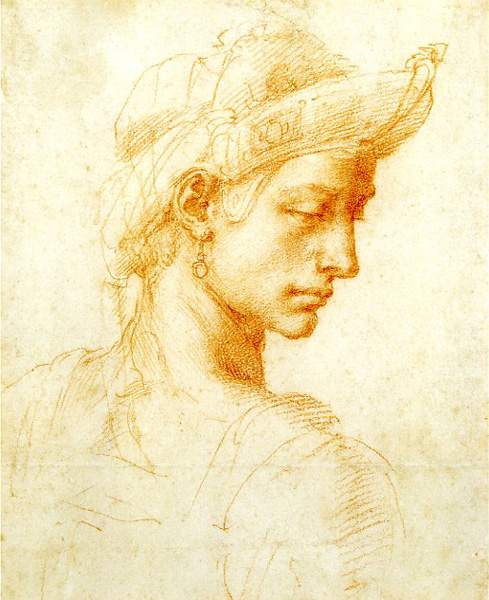
His Sistine Chapel ceiling is one of the virtually celebrated feats in art history, but those interested in drawings focus on the more than 90 chalk-and-ink works Michelangelo (1475–1564) made in preparation for this and other commissions. Some artists have fatigued the parallel between this Italian principal'south work and the fantastical, musculus-leap forms in comic books. Just if whatever aspiring draftsman over the last 50 years has approached the rippling human anatomy in comics with adoration, he has come to Michelangelo'due south piece of work with awe. "With his mastery of painting, sculpture and the architectural, no artist—with the possible exception of Leonardo—was more technically gifted," says Rhoda Eitel-Porter, the head of the department of drawings at the Morgan Library, in New York City. "His figures are e'er exerting themselves," observes Rubenstein. "They are striving for something but are bound. All the muscles are tensed simultaneously, which is anatomically impossible, but securely poetic. Michelangelo made a landscape of the human torso." The reason is logical: Michelangelo was a sculptor. The separation betwixt the tactile and the visual is broken down; the artist sees and draws in iii dimensions. "Michelangelo [understood] that a particular muscle is egglike in character, and he [would go] later that shape with his chalk," says Rubenstein, pointing out that the marks on his drawings increasingly hone in on more finished areas of the form in a way that parallels the chisel lines on an unfinished sculpture. The artist placed rough hatches in some places, more carefully defining crosshatching in others, and polished tone in the most finished areas. Michelangelo's work is marked past two other traits: his near complete dedication to the male nude and the omnipresent sensuality in his art. Even female person figures in his pieces were modeled after men, and even his drapery was sensual. "He could say everything he wanted to say with the male nude," notes Rubenstein. "He was non distracted by anything else—not landscapes, not still lifes, not female person nudes. With the exception of his architecture, Michelangelo was monolithically focused on the male nude, and even in his buildings, parallels could be made to the body."
Resources:
- Michelangelo Drawings: Closer to the Main, by Hugo Chapman (Yale University Press, New Oasis, Connecticut)
- Lessons From Michelangelo, by Michael Burban (Watson-Guptill Publications, New York, New York)
Albrecht Dürer

Albrecht Dürer (1471–1528) is arguably the greatest printmaker in history. He published more than than 350 engravings and woodcuts and completed at least 35 oil paintings, generating more than 1,000 preliminary drawings and watercolors in the process. Dürer created a number of widely known and iconic prints, and the Nuremberg artist is highly respected and influential amidst drawers. His nuanced delineation of forms—no like shooting fish in a barrel feat with a rigid, unforgiving engraving tool—is the reason so many draftsmen study and curiosity at his work. "His drawing comes out of a printmaker's sensibility," comments Rubenstein. "He cannot lay down tone; he has to hatch. And nobody stays on the form with the ruthlessness of Dürer." He was virtuosic, but perchance not innovative. "I remember he received a lot from the Italians," says Rubenstein, in reference to the artist's visit to Venice to run across a friend and investigate the art and ideas of Renaissance Italy. Simply his talent wasn't just in the execution of his technique. Dürer packed a lot of content in engravings such as Knight, Death, and Devil—including ii phantasmagorical figures that fascinate nevertheless don't dominate the rest of the limerick—merely the eye easily grasps the master idea when information technology isn't feasting on marvelously rendered roots and pebbles. Find the power of sketching in our costless due east-book of Sketch Cartoon Lessons. But enter your e-mail below to start enjoying cartoon explorations of art masters like these! [fw-capture-inline entrada="RCLP-confirmation-pencil-sketch-drawing" thank you="Thanks for downloading!" interest="Art" offer="/wp-content/uploads/pdfs/PencilSketchDrawingGheno.pdf"] "Y'all reply to the intensity and density of the image," states Rubenstein. "Dürer [depicted] the bizarreness of natural phenomena in corking detail, notwithstanding he [was] able to keep the big limerick clear and potent with all this going on. He [knew] that even inside the gnarliness of the trees, he [had] to back off a niggling bit so the hourglass [could] come frontwards. He [controlled] so much—he's similar a juggler that has xxx assurance upwardly in the air."
Resources:
- The Complete Engravings, Etchings, and Drypoints of Albrecht Dürer, by Albrecht Dürer (Dover Publications, Mineola, New York, New York)
- Albrecht Dürer and His Legacy: The Graphic Work of a Renaissance Artist, by Giulia Bartrum (Princeton University Press, Princeton, New Bailiwick of jersey)
Peter Paul Rubens
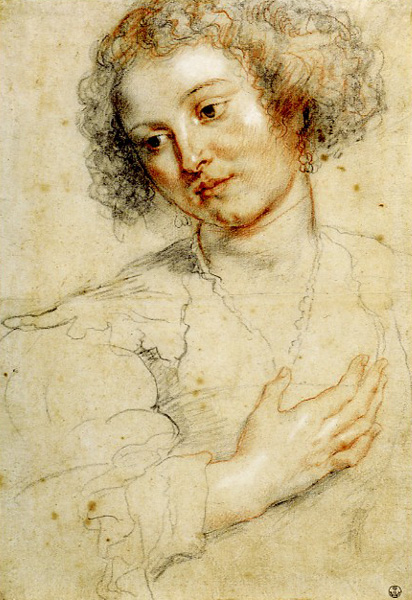
The stereotype has artists living a poor, Bohemian lifestyle, but Peter Paul Rubens (1577–1640) is evidence that some artists achieve immense success. Past almost accounts, Rubens was a well-respected, rich and happy creative person who also collected antiques, raised a large family, and secured a peace treaty or two while serving as a high-level diplomat. He was a busy homo of activity, and paper was never doodled upon frivolously—near all of his drawings were preliminary studies for grander commissions. One marvels fifty-fifty more at the confident, beautiful lines of Rubens' drawings in calorie-free of the knowledge that he most convincingly would consider them working documents, unsuitable for exhibition. What makes him special is "his mastery of the chalk technique," according to Eitel-Porter. "He needed just a few strokes to evoke non only the effigy'due south pose merely also its emotional state." Indeed, the Belgian courtroom painter demonstrated incredible facility in his drawings, with a hint of bombast. His manus was sure. "Rubens used naturally robust, confident marks and flowing gestures," says Rubenstein, who in particular admires the artist's drawings made with three colors of chalk. "Red chalk is cute, but information technology has a limitation on its range—you often desire to use black chalk and white chalk to increment it further on each end of the value range," Rubenstein explains. "It'due south like the departure between a chord and one note—extending the reach of red chalk."
Resources:
- Peter Paul Rubens: The Drawings, by Anne-Marie S. Logan (The Metropolitan Museum of Art, New York, New York)
- Peter Paul Rubens: A Bear on of Brilliance, by Mikhail Piotrovsky, (Prestel Publishing, Munich, Germany)
Rembrandt van Rijn
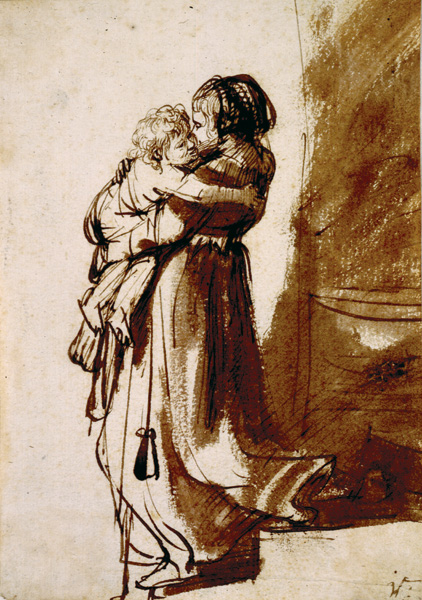
"He was an heir to Leonardo in that he was always sketching from nature," says Rubenstein in reference to Rembrandt (1606–1669). "His gestures were so true and full of life." If Rubens was the painter of power and the royal court, Rembrandt was the creative person of humanity. Gifted with the same power with line, the Dutch painter and draftsman had the skill to draw very quickly and to confidently add together unproblematic washes that efficiently established dark-light patterns. The unforgiving medium of ink was no hindrance to Rembrandt's pursuit of the moment'due south activity; the back of his wife's robe sweeps convincingly off the stair in Woman Conveying a Child Down Stairs, for instance. Mothers and children were of special involvement to the artist perhaps, in office, because he lost three children in their infancy; and his wife's death cutting brusque a happy spousal relationship. "The humanity of his drawings … yous don't experience information technology so pervasively in the work of anybody else," remarks Rubenstein. "He [seemed] to know what the female parent [felt] similar, what the child [felt] like—what's going on in the scene. And he [had] a spontaneous, incredible line that could prove the structure of something, and yet it [had] its own calligraphic sense."
Resource:
- Rembrandt's Journey: Painter, Draftsman, Etcher, by Clifford S. Ackley (MFA Publications, Boston, Massachusetts)
- The Drawings by Rembrandt and His School, Vol. I, by Jeroen Giltaij (Thames & Hudson, New York, New York)
- Drawings by Rembrandt and His School, Vol. Two, by Jeroen Giltaij (Thames & Hudson, New York, New York)
Charles Le Brun
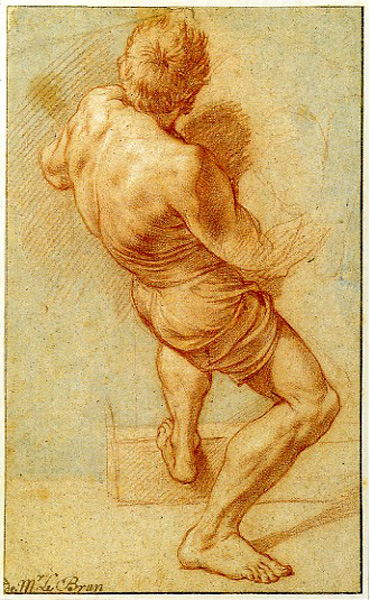
With a foot in both the classical and the Baroque eras, Charles Le Brun (1619–1690) was an artist who plant success early and had the political skills to remain a dominant effigy in the French court and the Académie until very late in life. Le Brun was a educatee of Vouet and a friend of Poussin, and his compositions were congenital on basic, simple masses, every bit in classicism. And yet, his figures could bristle with the energy of Bizarre art, as shown in the serpentine form in Study for Mucius Scaevola Before Porsenna.
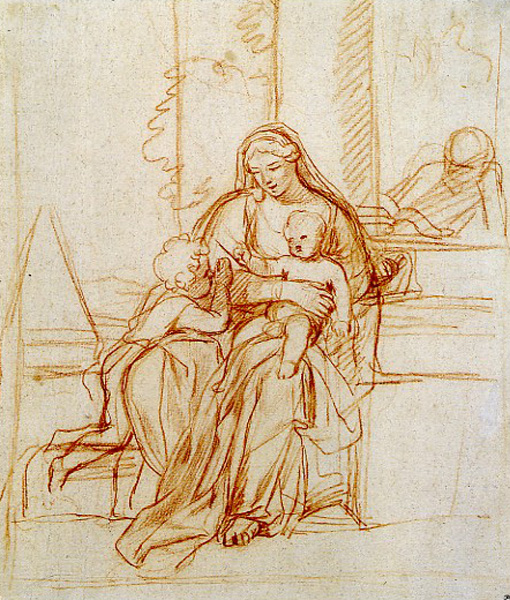
Le Brun did more than anyone to establish a homogenous French style of art for three decades in the 17th century. He accomplished this through both policy and painting—Le Brun founded the French University in Rome and, by the 1660s, any significant commission was assumed his for the taking. The two drawings shown in this section ably illustrate how Le Brun'south style pragmatically inverse with the times—with both artistic and material success. "Ane paradigm shows the simple conception of all the forms, very balanced and posed like a Raphael; and the other shows a figure struggling so hard," marvels Rubenstein. "Even without the indication of the corpse, which this figure is lifting, we feel how much effort he has to exert to concur up this heavyweight." Le Brun's surety with drawing instruments was legendary; 1 myth asserted that this son of a sculptor began drawing in the cradle.
Resource:
- Charles Le Brun: First Painter to King Louis XIV, by Michel Gareau (Harry Northward. Abrams, New York, New York)
- The Expression of the Passions: The Origin and Influence of Charles Le Brun`south Briefing sur fifty'expression générale et particulière, by Jennifer Montagu, (Yale Academy Press, New Haven, Connecticut)
Edgar Degas

The transformation for a draftsman from drawing tight, detailed forms to looser, more gestural lines is a common one, but these examples show this evolution in Hilaire-Germain-Edgar Degas (1834–1917) to exist a specially natural one. Beauty inhabits both works, even if a typical viewer may not associate both pieces with 1 artist. "He was trying to pin downwards the effigy in his early on drawings," explains Rubenstein, "and in the later drawings, he was setting it loose." Degas' muse was the ballerina, and the motion and movements of dance demanded free, gestural sketches. Rubenstein points out that even in quick sketches, such as Report of a Dancer in Tights, Degas is showing his genius for composition—the knees nearly touch the edges of the paper, and the negative shapes formed by the dancer's limbs create a powerful design. The beauty of the spontaneous composition betrays the years of experience behind this study.
Resource:
- Degas and the Trip the light fantastic, past Jill DeVonyar and Richard Kendall (Harry N. Abrams, New York, New York)
- Edgar Degas: Life and Work, past Denys Sutton (Rizzoli International Publications, New York, New York)
Vincent van Gogh

Bated from being the prototypical starving artist, Vincent van Gogh (1853-1890) was a midwife for the nascence of abstruse art, as evidenced in his Wild Vegetation. As a painter, he is renowned for his vibrant and bold color, but the risks he took with composition are perhaps every bit responsible for his reputation. For drawers, van Gogh is too important for his mark-making. "Van Gogh adult an incredible vocabulary with the reed pen," says Rubenstein. "He [made] up a linguistic communication, with all these unlike kinds of marks: dots, dashes, curls, long lines and brusk lines. Just because he [was] in such command, it [made] sense. He [made] rhythms. Nature doesn't have these marks."

Comparing Pollard Birches to Wild Vegetation shows the Dutch artist's growth from representational to the almost completely abstract. The transition is on view to a bottom extent in the portrait The Zouave, in which the majority of the face up is depicted with a kind of pointillism while specific features, such as the nose, are formed with classical lines. "It'due south a very personal linguistic communication he [came] upwardly with," comments Rubenstein. "But the marks themselves [are] mesmerizing."

:
- Vincent van Gogh: The Drawings, by Colta Ives (The Metropolitan Museum of Art, New York, New York)
- Van Gogh: Master Draughtsman,, by Sjraar van Heugten (Harry N. Abrams, New York, New York)
Egon Schiele
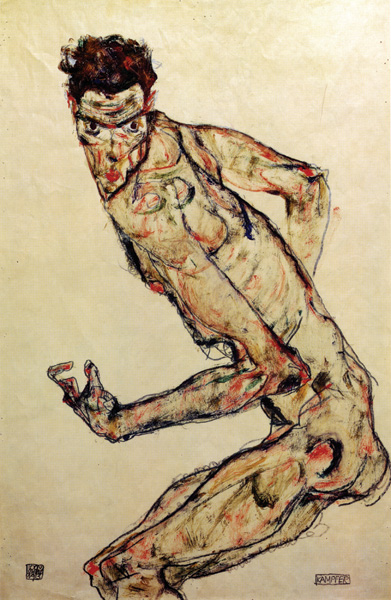
Austrian-born Egon Schiele (1890–1918) was a dandy cloaked in Maverick wearing apparel, a supposed pornographer, a determined narcissist and one of the nigh provocative and singular draftsmen of the modern historic period. "Compared to, say, Rembrandt, there's not a lot of range," says Rubenstein. "Only you always know if something is a Schiele. How does this happen? That'south worth thinking about." "All of his exaggerations are thoughtful," continues Rubenstein. "His distortions are on the coin—the indentation of a hip, the groovy of the haunch, a line that is clearly hamstrings. The distortions are based on very accurate anatomical landmarks. That's what makes them so disturbing. That, and the fact that the skeleton is oft very present." Schiele was maligned for some of his explicit drawings of underaged girls, only the dismissal of all his erotic art may be a mistake. Rubenstein points out that not everyone can attain the erotic successfully. Schiele's fine art challenges through non only its subject matter but also in the positions of his subjects, the wandering lines that vibrate with tension and the boisterous colors he employed. "Expect at the red adjacent to the green running through the figure in Fighter," observes Rubenstein. "It speaks of something unspeakable." Eitel-Porter concurs, "His use of unnatural colors and his gestural application of paint, with visible strokes to emphasize expression, sets Schiele apart."
Resources:
- Egon Schiele: The Complete Works, by Jane Kallir (Harry Due north. Abrams, New York, New York)
- Egon Schiele: Drawings and Watercolors, by Jane Kallir (Thames & Hudson, New York, New York)
Käthe Kollwitz

Käthe Kollwitz (1867–1945) saw much suffering and depicted it with an empathy rarely rivaled. Her husband was a doctor for the poor in Berlin, which probable played a role in her socialist sympathies. Losing her son in Globe War I prompted a lengthy depression. She too lost a grandson in World War II. As a issue, her heartbreaking images of mothers crying over deceased infants strike a resonating chord. "And she was such a keen draftsman," says Rubenstein. "Kollwitz could practise and then much with simple shapes. Over here may exist a few wispy marks signifying pilus; and then—boom, you are riveted right into that heart with a few strong lines." Kollwitz was primarily a graphic artist, circumscribed her work largely to black-and-white imagery. "Her bold, graphic mode reflects the immense human being pain and suffering of the underprivileged," comments Eitel-Porter. "That's the basis of her field of study matter. The world she depicts is veiled in shadow; simply rarely are touches of color introduced." Echoes Rubenstein, "With such simplicity, with such economy of means, she communicated great sympathy. She could make an incredible human argument with but burnt wood [charcoal] on paper."
Resource:
- Catalogue of the Complete Graphic Work of Käthe Kollwitz, by Baronial Klipstein (Oak Knoll Press, New Castle, Delaware)
- Käthe Kollwitz Drawings, by Herbert Bittner (Thomas Yoseloff, New York, New York)
*Article contributions by Bob Bahr
***
For more drawing tips, didactics, skilful insight and inspiration, check out by issues of Cartoon mag.
Source: https://www.artistsnetwork.com/art-history/masters-10-great-drawers-and-what-they-teach-us/
Post a Comment for "10 Cool Line Drawings Famous Examples"